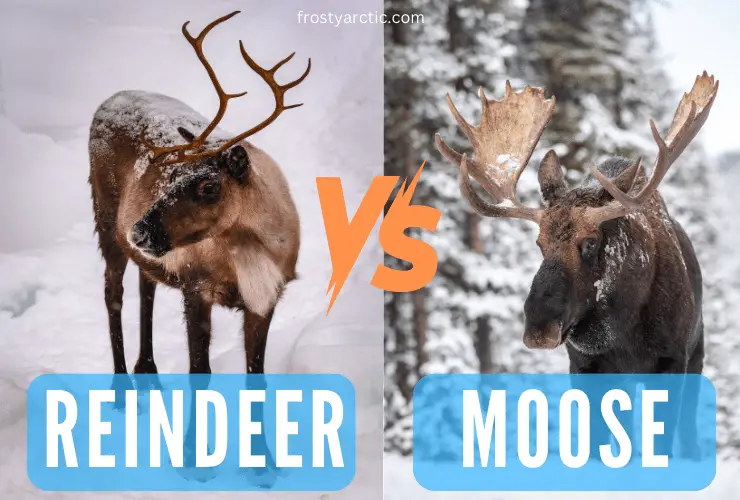Reindeer and moose are distinct in many ways though both belong to the deer family.
Moose are significantly larger, with males reaching up to 6.5 ft tall at the shoulder. In contrast, reindeer only reach about 4.5 ft. Both male and female reindeer are equipped with antlers, while in moose, only the males are equipped with antlers. Moreover, reindeer are famous for migrating, a behavior not seen in moose. Reindeer are social and live in herds; moose are more solitary animals.
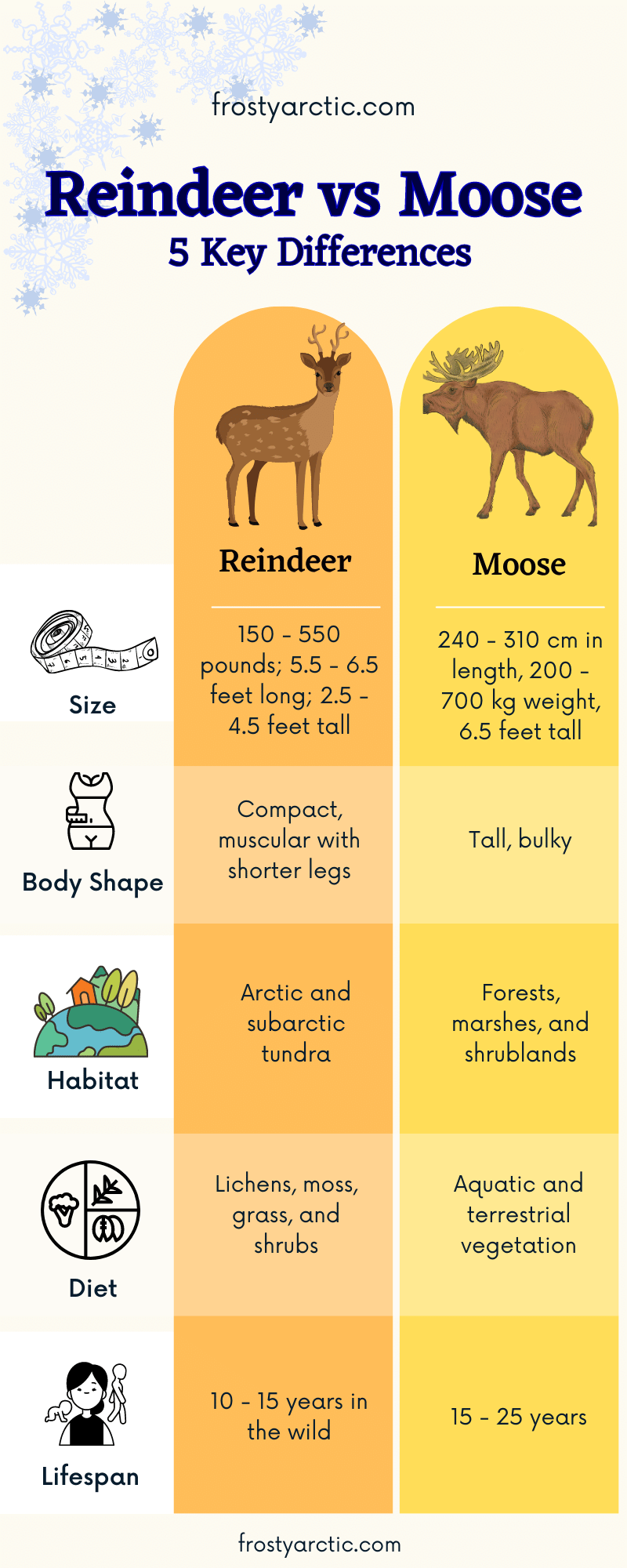
In the vast expanses of the northern hemisphere, two charismatic creatures play vital roles in the ecological fabric: the reindeer and the moose. Often, they are confused due to their similar habitats and shared family, the Cervidae. However, the complexities and contrasts between these two species run far deeper.
Keep reading to uncover the differences between the reindeer and the moose! Trust us. Let’s explore this fascinating forest of knowledge together!
Reindeer vs Moose: A Quick Comparison
| Feature | Reindeer | Moose |
| Scientific Name | Rangifer tarandus | Alces alces |
| Body Shape | Compact, muscular with shorter legs | Tall, bulky |
| Size | 150 – 550 pounds; 5.5 – 6.5 feet long; 2.5 – 4.5 feet tall | 240 – 310 cm in length, 200 – 700 kg weight, 6.5 feet tall |
| Diet | Lichens, moss, grass, and shrubs | Aquatic and terrestrial vegetation |
| Habitat | Arctic and subarctic tundra | Forests, marshes, and shrublands |
| Social Behavior | Herd animals; migrate in large groups | Mostly solitary, except during the mating season |
| Lifespan | 10 – 15 years in the wild | 15 – 25 years |
| Gestation Period | Approximately 7.5 months | Approximately 8 months |
| IUCN Status | Vulnerable | Least Concern |
Reindeer vs Moose: What Are the Key Differences?
Reindeer and Moose, two different deer species, are often considered one. Both are majestic creatures with impressive antlers, adapted to thrive in their respective frosty habitats. Additionally, they both exhibit similar feeding patterns, primarily grazing on a variety of vegetation.
But don’t be fooled by these similarities. There are striking differences between the Reindeer and Moose that set them apart in the animal kingdom. Let’s find out who’s who in the world of deer!
1. Taxonomy and Scientific Classification
Reindeer and moose are two of the most well-known species in the deer family, also known as Cervidae.
Reindeer
Reindeer are large deer scientifically known as Rangifer tarandus. These hoofed creatures are well known for their large, branching antlers that both males and females sport. This characteristic separates them from most other deer species, where usually only males have antlers.
Eight known subspecies of reindeer include:
- Barren ground (Rangifer tarandus granti)
- Santa’s (R.t. saintnicolas magicalus)
- Finnish forest (R.t. fennicus)
- European (R.t. tarandus)
- Woodland (R.t. caribou)
- Peary’s (R.t. pearyi)
- Svalbard (R.t platyrhynchus)
- Greenland (R.t. groenlandicus)
Moose
Conversely, Moose are the biggest members of the Cervidae family, scientifically known as Alces alces. They’re easily identifiable by their long faces, humped shoulders, and immense antlers sported by males.
There are eight recognized subspecies of moose which include:
- Eastern (Alces alces americana)
- Eurasian (Alces alces alces)
- Shiras (Alces alces shirasi)
- Alaskan (Alces alces gigas)
- Western (Alces alces andersoni)
- Siberian (Alces alces buturlini)
- Chukotka Moose (Alces alces buturlini)
- Ussuri Moose (Alces alces cameloides)
| Taxonomy | Reindeer | Moose |
| Kingdom | Animalia | Animalia |
| Phylum | Chordata | Chordata |
| Class | Mammalia | Mammalia |
| Order | Artiodactyla | Artiodactyla |
| Family | Cervidae | Cervidae |
| Genus | Rangifer | Alces |
| Species | tarandus | alces |
2. Habitat and Distribution
Both can be found in colder climates, but their exact habitats and ranges differ quite a bit.
Reindeer
Reindeer, referred to as caribou in North America, are incredibly adaptable. They’ve found ways to thrive in some of the harshest environments on earth.
- Arctic and Subarctic Regions: These areas form the core of the reindeer’s habitat. These include Alaska, Canada, Greenland, Scandinavia, and Northern Russia.
- Tundra and Boreal Forests: Reindeer are remarkably versatile, living in the wide, open tundra and the dense, snowy boreal forests.
- Altitude Range: Interestingly, reindeer also range into the mountains, climbing to high altitudes during summer, as described in an article published in Landscape Research.
Moose
Moose, on the other hand, are a little more particular about where they live.
- Northern North America: Moose can be found across Alaska, Canada, and the northern United States. In the U.S., they’ve even been sighted as far south as Colorado, as documented by the Alaska Department of Fish and Game.
- Europe and Asia: In Eurasia, moose live in Scandinavia, Russia, and the northern parts of China and Mongolia.
- Boreal Forests and Mixed Forests: Moose prefer forests’ dense cover. They are particularly fond of areas where forests meet wetlands, as these areas tend to have the best food.
| Aspect | Reindeer | Moose |
| Habitat | Tundra, Boreal forests. | Boreal forests, Temperate broadleaf, and mixed forests |
| Distribution in North America | Alaska, Canada | Alaska, Canada, Northern U.S. (Maine, Minnesota, Rocky Mountains, Colorado) |
| Distribution in Europe/Asia | Greenland, Northern Europe (Norway, Sweden), Northern Asia (Russia) | Scandinavia, Russia, Northern China, Mongolia |
3. Physical Appearance
Both are well-known members of the deer family, but their appearances can be quite distinct.
Reindeer
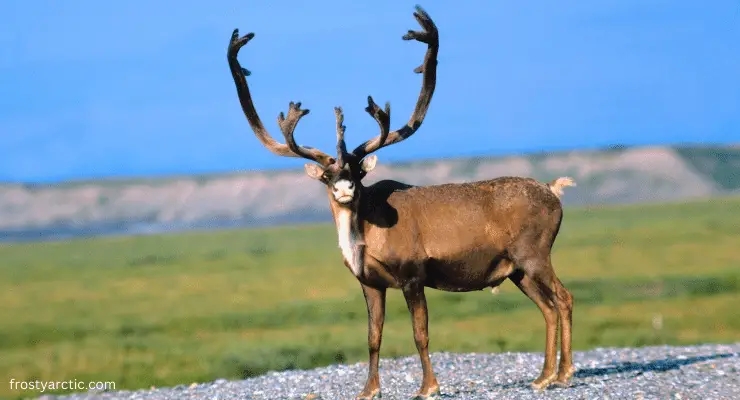
- Size: On average, reindeer are 1.8 – 2.1 meters long and stand about 2.5 to 5 feet at the shoulder. They weigh between 150 and 550 pounds, making them a medium-sized member of the deer family.
- Coat: Reindeer have a thick, woolly undercoat and a longer-haired overcoat that helps them survive in harsh winter conditions. Their fur can range from dark brown in summer to almost white in winter.
- Antlers: Both males and females grow antlers, which is unusual among deer species. These antlers are large and branchlike, with males generally having larger antlers than females.
- Legs: Reindeer have relatively short, muscular legs compared to other deer species. Their legs are well adapted for endurance walking and running, which comes in handy during their long seasonal migrations.
- Nose: They have a specialized nose that heats incoming chilly air before it reaches the lungs and a unique circulatory system adapted to handle low temperatures and high altitudes.
- Hooves: Reindeer have large, concave hooves that are adapted for a variety of tasks. They serve as paddles when swimming, scoops for digging in the snow for food, and provide solid footing on ice and rocky terrain.
Moose
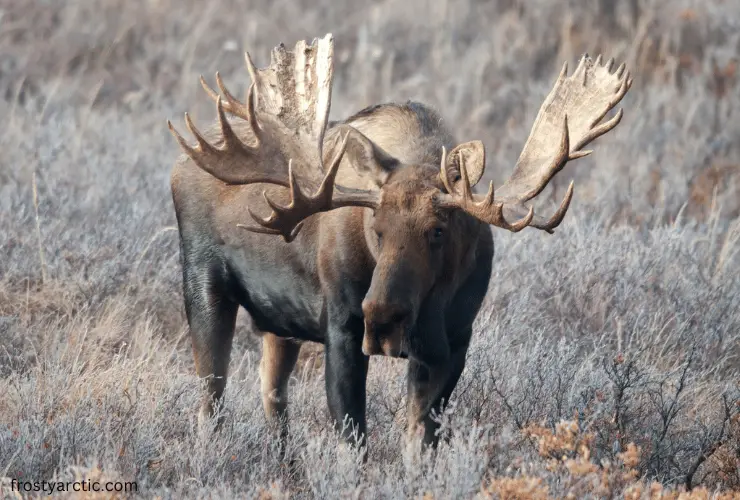
- Size: Moose are much larger than reindeer. They are 240 – 310 cm in length, stand about 6.5 feet tall at the shoulder, weighing around 200 to 700 kilograms. Some exceptionally large males have been known to weigh as much as 1,500 lbs!
- Coat: Moose have a dark brown coat that can appear almost black. Their fur is thick and protects them against the cold.
- Antlers: Unlike reindeer, only male moose grow antlers, which they shed and regrow yearly in preparation for the mating season. Moose antlers are broad and flat and can span up to 1.8 meters across.
- Legs: Moose have long, powerful legs that are well-suited for traversing the rugged northern landscapes and deep snow. The legs are also adapted for swift swimming, as moose are known to be excellent swimmers.
- Nose: Moose has a long and flexible snout. The overhanging upper lip is larger than the lower.
- Hooves: Moose have large, rounded hooves that are ideal for navigating through deep snow and swampy terrain. They also have a dewclaw that helps them maintain balance on uneven ground and steep slopes. ~Source
| Physical Features | Reindeer | Moose |
| Size | 85 to 150 cm at the shoulder, 70 to 150 kg | 1.4 to 2.1 m at the shoulder, 380 to 700 kg |
| Coat | Thick, woolly, color ranges from dark brown to white | Dark brown, thick and insulating |
| Antlers | Both males and females have branchlike antlers | Only males have broad, flat antlers |
| Legs | Short, muscular legs | Long, powerful legs |
| Nose | Specialized nose that warms incoming cold air | Long and flexible snout with a larger upper lip than the lower |
| Hooves | Large, concave hooves | Large, rounded hooves |
4. Diet and Feeding Habits
Despite both being herbivores, the types of plants these two species prefer can differ quite a bit.
Reindeer
Reindeer have adapted to make the most out of their challenging environment:
- Lichens: They are the only large mammal capable of eating lichens. This food source allows them to inhabit the Arctic and Subarctic.
- Grasses and Shrubs: In the summer, they shift their diet to include more grasses, shrubs, and leafy greens. This diverse diet helps them bulk up for the winter.
- Mushrooms: They’re also known to snack on mushrooms when they can find them.
They use their large, concave hooves and strong legs to dig through the snow and reach their food.
Moose
On the other hand, Moose are less specialized and eat a broader range of plants:
- Aquatic Plants: Moose enjoy eating aquatic plants. These provide important nutrients that they might not get elsewhere.
- Woody Plants: They’re also big fans of the twigs, bark, and buds of woody plants. In fact, this makes up a significant portion of their diet in winter. Their chosen foods are Willow, birch, aspen, maple, fir, and viburnum.
- Leaves and Grasses: When available, they’ll graze on leaves, grasses, and other greenery. ~Source
Moose, with their long, muscular legs and flexible upper lips, adeptly browse aquatic plants. They can even dive underwater to access fresh greens.
| Diet | Reindeer | Moose |
| Primary Diet | Lichens, Grasses, Shrubs | Aquatic plants, Woody plants |
| Secondary Diet | Mushrooms | Leaves, Grasses |
5. Social Behavior
Reindeer and Moose social behaviors are, in many ways, as distinct as their physical characteristics.
Reindeer
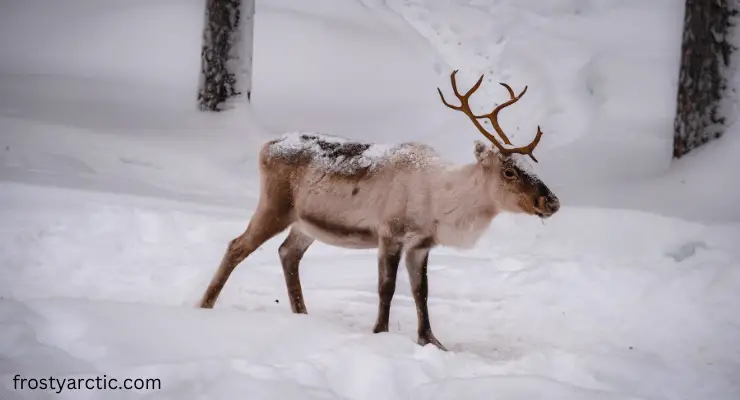
Reindeer are incredibly social creatures, and their lives revolve around their herds:
- Herd Life: Reindeer live in large herds, with group sizes varying based on the season, food availability, and other factors.
- Migration: Reindeer are famous for their long-distance migrations. Some herds travel over 1,000 miles per year in search of food!
- Hierarchy: Reindeer herds have a clear hierarchy, typically with an alpha male and female. This hierarchy becomes particularly important during the breeding season.
- Mating season: During the mating season, males fight with each other for access to females. These competitions can involve locking antlers and pushing against each other.
Moose

Moose, on the other hand, tend to be more solitary:
- Solitary Lifestyle: Unlike herd-focused reindeer, moose are more solitary animals. They generally stay within a certain home range unless they’re disturbed or seeking a mate.
- Mating Season: During this time, males will fight with each other for the right to mate with a female. This can involve aggressive displays and fights using their large antlers.
- Mother and Calf: The mother-calf pair is the primary social unit for moose. The calf will stay with its mother for up to a year before living alone.
| Aspect | Reindeer | Moose |
| Social Behavior | Herd life | Mostly solitary, except during mating season |
| Dominance Displays | Antler locking and pushing | Aggressive displays and antler fights |
| Migratory Behavior | Long-distance migrations. | Generally, stays within the home range |
6. Reproduction and Lifecycle
Both reindeer and moose have intriguing rituals and behaviors tied to their reproduction and lifecycle.
Reindeer
- Mating Season: Reindeer typically mate around September to November. The exact timing can vary based on location and environmental conditions.
- Gestation and Birth: After mating, the female will carry the calf for about 7.5 months. Most calves are born in May or June.
- Calves: Reindeer calves are quick learners. They can stand shortly after birth and are usually able to run with the herd within a day, as described in Animal Reproduction Science.
Moose
- Mating Season: Moose typically mate in the fall, usually around September or October.
- Gestation and Birth: After a gestation period of about 8 months, the female gives birth to 1 to 2 calves in May or early June.
- Calves: Moose calves stay with their mother for about a year. During this time, they learn how to survive and navigate their environment. After this, they’re generally ready to go out independently, as explained in the book Handbook of the Mammals of Europe.
| Reproduction | Reindeer | Moose |
| Mating Season | Late September to early November | Fall (around September or October) |
| Gestation and Birth | About 7.5 months, birth in May or June | About 8 months, birth in May or early June. |
| Offspring | Calves can run with the herd within a day | Calves stay with their mother for about a year |
| Lifespan | 10 – 15 years in the wild | 15 – 25 years in the wild |
7. Natural Predators
Even though reindeer and moose are quite large, they still have to watch for potential threats.
Reindeer
Wolves are one of the main predators of reindeer. They can take down an adult reindeer if they work together in a pack.
Other animals, including mountain lions, Arctic foxes, Brown bears, and Coyotes, also pose a threat, especially to young reindeer calves.
It might surprise you, but golden eagles can also be a danger, particularly to newborn calves or weakened adults.
Moose
Like reindeer, moose need to watch out for wolves. A wolf pack can bring down a moose, especially if it’s young, old, or sick.
Black bears, grizzlies, coyotes, wolverines, cougars, and orcas also prey on moose. They’re particularly likely to go after calves or weakened adults. ~Source
| Species | Natural Predators |
| Reindeer | Wolves, brown bears, golden eagles, mountain lions, Arctic foxes, coyotes |
| Moose | Wolves, grizzly bears, black bears, coyotes, wolverines, cougars, orcas |
8. Defense Mechanism
Each species has a unique set of defense mechanisms that help them fend off threats.
Reindeer
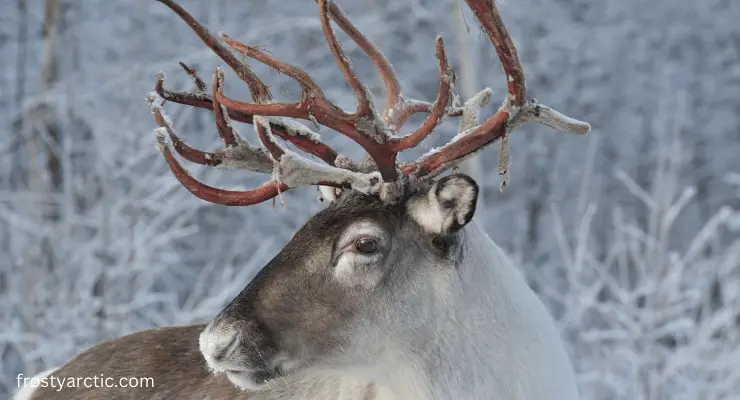
- Speed: Reindeer are surprisingly fast runners. They can reach speeds of up to 80 km/h, which is handy when a predator is in pursuit.
- Herd Safety: Being part of a large herd can also be a form of defense. It’s harder for a predator to single out an individual when there are so many potential targets.
- Antlers: Male and female reindeer both have antlers that can also be used to defend against predators.
Moose

- Size: Moose are massive, and their size alone can deter many predators.
- Antlers: Male moose have large, impressive antlers that they can use to defend themselves against threats.
- Aggression: If a moose feels threatened, it can become very aggressive. A charging moose is a formidable opponent for any predator.
| Species | Defense Mechanisms |
| Reindeer | Speed, Herd Safety, Antlers |
| Moose | Size, Antlers, Aggression |
9. Interaction With Humans
Both reindeer and moose have a rich history of interactions with us, and each relationship is distinct.
Reindeer
Reindeer have been interacting with humans for thousands of years:
- Domestication: The Sami people of Scandinavia and the Nenets people of Russia have traditionally herded reindeer for millennia. They rely on the reindeer for food, clothing, and transport.
- Tourism: Reindeer sledding is a popular tourist activity in certain regions, particularly in Scandinavia.
Moose
Moose interactions with humans are different:
- Wildlife Viewing: Moose is a popular wildlife attraction. In areas like Alaska and Canada, tourists often go on moose-viewing tours.
- Hunting: Moose hunting is regulated in many areas where moose live. Hunters prize them for their size and the challenge of the hunt.
- Vehicle Collisions: Moose are known for their unfortunate habit of wandering onto roads, which can lead to dangerous encounters with cars.
| Species | Interaction With Humans |
| Reindeer | Domestication, Tourism |
| Moose | Wildlife Viewing, Hunting, Vehicle Collisions |
10. Threats and Conservation Status
Even though both reindeer and moose face significant threats, their conservation statuses differ.
Reindeer
As Arctic animals, reindeer are directly impacted by climate change. Rising temperatures can affect the availability and quality of their food sources.
Reindeer populations are also affected by:
- Habitat Loss due to industrial development, including mining and oil drilling.
- Overhunting
According to the IUCN Red List, reindeer are ranked as “Vulnerable,” with a high risk of extinction in the wild.
Moose
Like reindeer, moose are also impacted by climate change. Warmer temperatures can lead to an increase in parasites and diseases that affect moose.
Other threats include
- Habitat Loss due to logging and development
- Vehicle Collisions.
The moose is listed as a species of “Least Concern” on the IUCN Red List, with no immediate risk of extinction. However, local populations in some areas have been declining.
| Aspect | Reindeer | Moose |
| Major Threats | Climate change, Habitat loss, Overhunting | Climate change, Habitat loss, Vehicle collisions |
| IUCN Status | Vulnerable | Least Concern |
Wrapping Up
So, are reindeer and moose the same? Definitely not! Even though they both share the Cervidae family lineage, they are distinctly different species. Each has evolved wonderfully to suit their distinctive environments, with diets, behaviors, and human interactions shaped accordingly.
From the snowy tundras where reindeer migrate to the forested wetlands where moose dominate, their differences underscore the astounding variety of life.
We hope this blog has helped you distinguish between reindeer and moose. Feel free to come back for more insightful comparisons!

